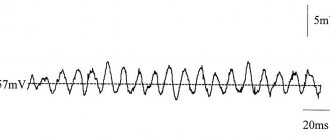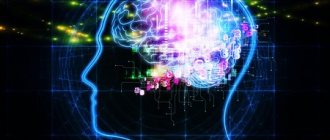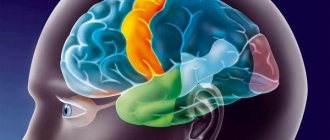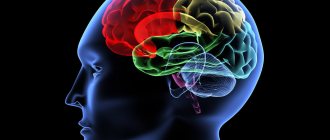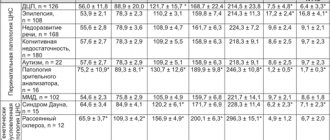EEG (electroencephalography) of the brain is a highly informative method for diagnosing the state of the central nervous system, based on recording the bioelectric potentials of the cerebral cortex during its life. The results of the study are recorded on paper tape or displayed on a computer monitor. Neurophysiologists at the Yusupov Hospital interpret the EEG results of the brain in adults using a computer program.
The patient receives a conclusion on the second day. If the results of EEG decoding are interpreted ambiguously, they are discussed at a meeting of the expert council with the participation of professors and doctors of the highest category. Leading neurologists and neurophysiologists collectively make decisions regarding the diagnosis and further tactics of patient management. The results of an EEG of the brain performed at the Yusupov Hospital are always accurate, since the study is carried out using the latest European and American equipment, and the decoding is done by candidates of medical sciences who have been trained in the best domestic and foreign diagnostic centers.
Normal EEG in adults
Decoding the EEG results consists of three sections:
- description of leading types of activity and graphic elements;
- conclusion after description with interpreted pathophysiological materials;
- correlation of the indicators of the first two parts with the clinical picture of the disease.
The main descriptive term in EEG is "activity". He evaluates any order of waves. The main types of activity that are recorded during the study and subsequently subjected to decoding, as well as further study, are the frequency, amplitude and phase of the waves. Frequency is measured by the number of wave oscillations per second. It is expressed in units of measurement - hertz (Hz). In the description, the neurophysiologist indicates the average frequency of the activity being studied.
Amplitude is the range of wave oscillations of the electrical potential. It is measured by the distance between the peaks of waves in opposite phases, expressed in microvolts (µV). A calibration signal is used to measure the amplitude. When interpreting the results, neurophysiologists interpret the most common values, completely excluding the rare ones.
The phase evaluates the current state of the process and determines its vector changes. Using an electroencephalogram, functional diagnostic doctors evaluate certain phenomena and evaluate the phases they contain. Oscillations are monophasic, biphasic and polyphasic.
Electrical rhythms of the brain
The concept of “rhythm” in the EEG is considered to be a type of electrical activity that relates to a certain state of the brain and is coordinated by appropriate mechanisms. When deciphering indicators of the EEG rhythm of the brain, neurophysiologists take into account its frequency corresponding to the state of the brain region, amplitude and characteristic changes during functional changes in activity.
The characteristics of brain rhythms depend on whether the patient is asleep or awake. Brain activity recorded on the EEG in an adult has several types of rhythms, which are characterized by certain indicators and the state of the body.
On the EEG, the alpha rhythm is characterized by a frequency of 8 to 14 Hz. It is present in most healthy individuals. The highest amplitude values are observed in the resting state of the subject, who is in a dark room with his eyes closed. The alpha rhythm is best determined in the occipital region. It can be fragmentarily blocked or completely subside during visual attention or mental activity.
The wave frequency of the beta rhythm on the EEG fluctuates in the range of 13–30 Hz. Its main changes are observed when the subject is active. Pronounced fluctuations are detected in the frontal lobes under the obligatory condition of active activity (mental or emotional arousal).
The gamma rhythm has an oscillation range from 30 to 180 Hz. It is characterized by a rather reduced amplitude - less than 10 μV. Exceeding the amplitude limit of 15 μV is considered a pathology that causes a decrease in intellectual abilities. Rhythm is determined when solving situations and tasks that require increased concentration and attention.
The kappa rhythm is characterized by an interval of 8–12 Hz. It is observed in the temporal part of the brain during mental activity by suppressing alpha waves in other areas. The lambda rhythm has a range of 4–5 Hz. It is triggered in the occipital region when it is necessary to make visual decisions (searching for an object with open eyes). The vibrations disappear completely after concentrating your gaze on one point. The mu rhythm has an interval of 8–13 Hz. It starts in the back of the brain and is best observed in a calm state. Suppressed when any activity is started.
A separate category of types of rhythms that manifest themselves in sleep conditions or in pathological conditions includes 3 types of this indicator:
- The delta rhythm is determined in comatose patients and in the deep sleep phase, and is recorded when recording signals from areas of the cerebral cortex located on the border with areas affected by malignant neoplasms;
- the theta rhythm has a frequency range of 4–8 Hz, manifests itself during sleep, is responsible for the high-quality assimilation of information, and underlies self-learning;
- The sigma rhythm has a frequency of 10–16 Hz, is considered one of the noticeable and main oscillations of the spontaneous electroencephalogram, and occurs during natural sleep at its initial stage.
Based on the results obtained from recording the EEG, an indicator is determined that characterizes a complete all-encompassing assessment of the waves - the bioelectrical activity of the brain. A functional diagnostics doctor checks EEG parameters - frequency, rhythm and the presence of sharp flashes that provoke characteristic manifestations. On these grounds, the neurophysiologist makes a final conclusion.
Rhythms of brain activity and their stimulation. Theory
As you know, the human brain operates with electrical signals. It constantly generates electrical impulses called brain waves (or brain rhythms, brain waves, waves of brain activity). The frequency of these pulses is measured in hertz or cycles per second. Well, the dominant frequency of brain waves determines the general state of the brain.
Why dominant? The thing is that the brain does not work as a whole at one frequency. This means that one area of the brain may produce more beta waves while other areas of the brain emit impulses at a different frequency. In general, he may be in a state of calm relaxation, for example, but part of the subcortex will be “itching” about stress and problems at the background level.
Waves (rhythms) of human brain activity are divided by scientists into six main types: delta, theta, alpha, sigma, beta and gamma. For those interested in going straight to applied listening, here: “Rhythms of brain activity and their stimulation. Audio" .
They write that the rhythms of electromagnetic oscillations of our brain are directly related to electromagnetic oscillations between the Earth’s surface and the ionosphere, coinciding with them in the main resonant frequencies. Probably, here is the key to the existence of large and small rhythms of the world’s existence, some of which are represented in a person in different ways, and some, resonant with them, in the surrounding space. Like a guitar string makes a sound in unison with a tuning fork, like a bridge begins to vibrate in resonance with the wind, and so on. () Likewise, we can tune in to different cycles and frequencies in the world, entering into resonance with them using simple techniques. One of them is as old as human societies. It `s music. Especially rhythmic.
Alpha rhythm (α rhythm, alpha rhythm) - EEG rhythm (electroencephalogram) in the frequency band from 8 to 13 Hz, average amplitude 30–70 μV, however, high and low amplitude α waves can be observed. It is registered in 85–95% of healthy adults. It is best expressed in the occipital regions. The α rhythm has the greatest amplitude in a state of quiet wakefulness, especially with eyes closed in a darkened room. It is blocked or weakened by increased attention (especially visual) or mental activity.
The alpha rhythm characterizes the process of a person’s internal “scanning” of mental images when focusing on some mental problem.
When we close our eyes, alpha rhythms intensify, and this property is successfully used during meditation-relaxation or a hypnosis session. For most people, alpha waves disappear when they open their eyes and a real picture appears before them. Statistical and experimental data indicate that the nature of the alpha rhythm is innate and hereditary.
Most people with a clearly defined alpha rhythm have a predominant ability for abstract thinking. A small group of people exhibit a complete absence of alpha rhythms, even with their eyes closed. These people think freely in visual images, but have difficulty solving problems of an abstract nature.
People who have learned to analyze information when their brain works in the alpha rhythm have access to much larger volumes of information, creative ideas and inspired thoughts are more likely to come to them, intuition is sharpened, which allows them to find new unexpected solutions to problems. No wonder they say: “Close your eyes, and the solution will come by itself.”
When the brain works in the alpha rhythm, a person's potential for managing his life increases. An understanding comes of how to better deal with various life problems, such as excess weight, insomnia, anxiety, tension, migraines, bad habits and much more. There is an opportunity to learn how to adjust your psyche in such a way as to achieve your goals and turn your dreams into reality.
The work of the brain in the alpha rhythm allows you to quietly enter a state of shallow meditation, as during auto-training and relaxation exercises. Scientists have found that when a person engages in such practices, at the physiological level there is a decrease in the rhythm of brain functioning to the level of alpha rhythm. Taking a warm bath or shower is directly related to the dominance of the alpha rhythm.
Why is the alpha rhythm so remarkable and why does the human body need it? Everything depends on the human consciousness. In a state of complete relaxation and immersion, alpha waves intensify, and healing and cleansing processes begin in our psyche, hidden resources awaken: intuition comes to life, concentration becomes perfectly honed, and extrasensory abilities appear. The world around begins to play with completely different colors, making a person joyful.
Beta rhythm (β rhythm) is a low-amplitude oscillation of the total brain potential with a frequency of 15 to 35 oscillations per second, amplitude - 5-30 μV. This rhythm is inherent in the state of active wakefulness. Refers to fast waves. This rhythm is most strongly expressed in the frontal areas, but with various types of intense activity it sharply intensifies and spreads to other areas of the brain. Thus, the severity of the beta rhythm increases when a new unexpected stimulus is presented, in a situation of attention, during mental stress, and emotional arousal. Their amplitude is 4–5 times less than the amplitude of alpha waves.
In a state of beta rhythm, our brain is immersed in the routine of life with a huge number of different problems, in an endless cycle of stressful situations, solving various problems and active concentration, a moving focus of attention. Attention is directed outward.
The beta rhythm is by no means our enemy. It was thanks to the beta rhythm that humanity reached immeasurable heights in technological progress: it built cities, went into space, created television, computers; The development of medicine is also directly related to these waves. This is the rhythm of active creation and life.
Gamma rhythm (γ rhythm) - fluctuations in EEG potentials in the range from 30 to 120–170 to fluctuations per second. The amplitude of the gamma rhythm is very low - below 10 μV and is inversely proportional to frequency. If the amplitude is higher than 15 μV, then the EEG is considered pathological. The gamma rhythm is observed when solving problems that require maximum concentrated attention. The gamma rhythm reflects oscillations that are simultaneously triggered in neurons by an incoming signal from the activating system of the reticular formation, causing a shift in the membrane potential.
The gamma rhythm is observed when solving problems that require maximum concentrated attention. This is the rhythm of composure and concentration on a problem or task, the rhythm of an active collected solution and work. There are theories connecting this rhythm with the work of consciousness. A number of publications report various disorders of gamma activity in patients with schizophrenia.
Gamma rhythm is also a state of communication between a person and “something” that is beyond the understanding of our consciousness. The brain vibration frequency of 50 Hz is what some researchers of Buddhist meditators call enlightenment. Although this is doubtful. This is simply the frequency of maximum concentration, presence here and now. That is, the gamma rhythm allows us to become someone greater and perceive the world from the point of view of this greater one. It's like a superstructure on human consciousness that we can use.
Delta rhythm - from 0.5 to 4 oscillations per second, amplitude - 50-500 µV. This rhythm occurs both during deep natural sleep and during narcotic sleep, as well as during coma. The delta rhythm is also observed when recording electrical signals from areas of the cortex bordering the area of the traumatic lesion or tumor. Low-amplitude (20–30 μV) fluctuations in this range can be recorded at rest during some forms of stress and prolonged mental work.
Characteristic of the stage of deep sleep without dreams. And also, for a state of very deep meditation-dhyana (not relaxation, like the alpha rhythm).
Theta rhythm (θ rhythm) - EEG rhythm Frequency 4–8 Hz, high electrical potential 100–150 microvolts, high wave amplitude from 10 to 30 μV. The theta rhythm is most pronounced in children from two to five years old. This frequency range promotes deep relaxation of the brain, good memory, deeper and faster assimilation of information, awakening individual creativity and talents.
For the most part, in children under 5 years of age, the brain functions in this wavelength range during the daytime, which allows children to phenomenally remember a huge amount of various information, which is unusual for adolescents and adults. In the natural state, this rhythm dominates in the majority of adults only during the REM sleep phase, half-asleep. Characteristic for deep meditation-dhyana. It is in this frequency range that the brain has enough energy to absorb large amounts of information and quickly transfer it to long-term memory, learning abilities are enhanced and stress is relieved. In this range, the brain is in a state of heightened sensitivity. This state is ideal for superlearning; the brain is able to maintain concentration and extroversion for a long time and is not susceptible to anxiety and neurotic manifestations.
This is the range of the upper connections of the brain, connecting both hemispheres and directly the layers of the cerebral cortex with its frontal zones.
Sigma Rhythm - Spontaneous sigma rhythm has a frequency of 10 to 16 Hz, but generally ranges from 12 to 14 vibrations per second. The Sigma rhythm is a spindle-shaped activity. This is explosive or flash activity, spindle-shaped flashes recorded in a state of natural sleep. It also occurs during certain neurosurgical and pharmacological interventions. A characteristic feature of the sigma rhythm is the increase in amplitude at the beginning of the sigma rhythm burst and its decrease at the end of the flash. The amplitude varies, but in adults it is generally at least 50 µV. The Sigma rhythm appears in the initial stages of slow-wave sleep, which immediately follows drowsiness. During sleep with delta waves, the sigma rhythm rarely occurs. During the transition to REM sleep, the sigma rhythm is observed in the EEG, but is completely blocked in the developed phase of REM sleep. In humans, this rhythm occurs from about three months of age. With age, the frequency of rhythm fluctuations, as a rule, does not change.
Instant relaxation and stress relief - uses frequencies between 5 and 10 Hz for varying levels of relaxation.
Sleep replacement - a thirty-minute session at 5 hertz replaces 2-3 hours of sleep, allowing you to wake up early in the morning more alert, listen for half an hour before falling asleep and getting up in the morning.
Fighting insomnia - waves between 4 and 6 hertz in the first 10 minutes, then moving to frequencies below 3.5 Hz (for 20-30 minutes), gradually descending to 2.5 Hz before ending.
Raising tone - theta waves (4-7 Hz) for 45 minutes a day.
You can also read about the rhythms of brain activity here and here.
Stimulation of brain rhythms
Let's look at ways available to every person to stimulate brain rhythms to improve natural abilities, including memory and creative insights.
Alpha rhythm stimulation
People have different levels of alpha wave production. For some, the level of these waves is naturally very low, for others, on the contrary, it is high. In children, alpha and theta waves predominate. Therefore, children do not need alpha rhythm stimulation.
As we grow older, our brains begin to produce more beta waves. Psychologists say that the alpha rhythm predominates in extroverts (outgoing optimists who easily interact with society) and is significantly reduced in introverts (restrained, slightly shy and withdrawn people focused on their inner world). Stimulating alpha waves helps introverts feel more confident in society.
Ways to increase alpha rhythm are:
- Synchronization of waves with external signals. It consists of listening to certain tracks made up of stereo signals (see more details below).
- Daily meditation-relaxation requires practice and time. For beginners, it is enough to devote 20 minutes a day to training to learn how to relax.
- Yoga - promotes complete relaxation of the body and increases the level of alpha waves. Proper and constant yoga practice will help you consciously control your alpha rhythm.
- Deep breathing is a method of saturating brain cells and the body with oxygen. By mastering this method and making it a habit, you will help your brain automatically tune in to the alpha rhythm.
- Visualization. As soon as we close our eyes and start dreaming, drawing positive images, our brain immediately begins to actively produce alpha waves.
- Alcohol is an effective but unhealthy way to get high. People easily get used to relieving stress with alcohol. When taken, there is a sharp increase in the production of alpha waves, resulting in a state of relaxation and tranquility. That is why, by stimulating alpha waves with special equipment, you can do the opposite - treat alcoholism and drug addiction.
Negative effects that occur with excessive stimulation of the alpha rhythm include increased drowsiness, fatigue, and even depression. It is important to understand your condition. If you feel tired, sleepy and starting to feel depressed, it means that your brain needs stimulation not from alpha waves, but from beta waves.
Increasing the alpha rhythm will be useful in cases of depression associated with fear, nervousness and tension. There is no need to increase the alpha rhythm in a calm, relaxed state with a clear mind. This can lead to feelings of disappointment, boredom, and loss of interest in life. When these effects occur, you need to stop alpha wave stimulation and increase the beta rhythm.
Beta rhythm stimulation
How does stimulating the brain with beta waves benefit a person? These waves naturally begin to dominate conversation and learning activities. Increasing the beta rhythm improves social skills, mental abilities, raises energy levels, sharpens the senses, and concentrates attention. Researchers have found that people with above average IQ have increased brain production of beta waves. This is not surprising, because these waves speed up brain function and increase the perception of educational information. Beta stimulation is useful for those who feel tired and overwhelmed during the day.
Ways to stimulate beta waves:
- Synchronization of waves - using music containing binaural beats (see more details below).
- Reading interesting books increases the activity of the left hemisphere and the production of beta waves.
- Caffeine increases beta waves, but only for a short time. Energy drinks and smoking, which are harmful to the body, cause a surge in wave activity. However, soon after getting up, you will feel a sharp drop in energy and spend the rest of the day in a broken state.
Beta wave stimulation is recommended for people suffering from chronic fatigue and in emergency situations when urgent work needs to be done in a short time.
Disadvantages of increasing beta rhythm . If you have naturally elevated levels of beta waves, then additional stimulation will lead to feelings of fear, unexplained anxiety and even panic. The beta rhythm increases muscle tension and blood pressure. These waves affect the processes of excitation of the nervous system and relieve drowsiness. Therefore, hypertensive patients and those suffering from insomnia should not get carried away with stimulating beta waves.
Theta Wave Stimulation
The theta rhythm brings our body into a state of deep relaxation, during which we dream. These waves are a thin border between consciousness and subconscious. Under their influence, self-healing mechanisms are launched in the body, and physical and spiritual condition improves. Thanks to deep relaxation with the theta rhythm, our body quickly recovers after heavy exertion.
Entering the theta rhythm state contributes to the emergence of a deep connection with the subconscious and the emergence of paranormal abilities (exit of consciousness beyond the limits of the physical body, establishing contact with the other world, extrasensory perception). Staying in it brings us feelings of bliss and peace.
Psychotherapists use instrumental and other theta wave stimulation to treat patients for mental trauma. The principle of treatment is based on a person’s recollection of a traumatic event hidden in the depths of the subconscious and a change in attitude towards it.
Greater theta wave activity is found in children and creative people. The theta rhythm awakens and strengthens our emotions and feelings, allows us to program the subconscious, and get rid of negative thinking.
Ways to stimulate theta waves:
- Synchronization of the brain with special rhythms.
- Listening to pleasant music. The sounds of such music are associated with the production of emotions and sensations, and this is a direct way to increase the activity of theta waves.
- Meditation (light relaxation and dhyana with some immersion) - produces alpha and theta rhythm. It is easiest to learn how to produce alpha waves, and only after positive training comes the ability to control the theta rhythm.
- Hypnosis and self-hypnosis. Allows you to strengthen the alpha and theta rhythm.
- Yoga helps to consciously control the state of theta waves and get the maximum benefit from it.
Unhealthy ways to increase theta rhythm include taking hallucinogenic drugs and alcohol. In a state of alcoholic intoxication, the activity of alpha waves first increases, a feeling of peace and relaxation sets in, then a phase of violent activity begins - beta rhythms, then they are replaced by theta oscillations. Chronic alcoholics experience constant theta activity, which impairs their speech, memory, and thinking abilities.
Mindful meditation, yoga and hypnosis help a person to know himself, immerse himself in the subconscious, and learn to produce alpha and theta waves.
Disadvantages of increasing theta brain activity include:
- Theta stimulation is not suitable for dreamy people who are prone to fantasizing, as it will make them even more distracted.
- An increase in the theta rhythm leads to decreased concentration and drowsiness. Therefore, you should not stimulate theta waves before work. Just like alpha, theta oscillations in large quantities cause apathy and boredom.
Delta Wave Stimulation
Stimulating delta waves is the most difficult process, since delta waves “shape” the subconscious and in the subconscious. Ordinary people are in a state of delta rhythm dominance only in deep sleep, coma or unconsciousness. Only experienced healers, psychics, shamans, and experienced meditators can consciously control delta oscillations. Without studying special techniques and methods, without a competent assistant, it is not recommended to increase delta brain activity on your own.
The easiest way to achieve sustained delta waves is to breathe rhythmically at a rate of about 60 breaths per minute.
This method is used by shamans in ritual dances before going to the “subtle” world for answers to their questions.
Synchronization of waves with external signals
Our brain has the ability to synchronize its dominant frequency with an external signal, this is called “frequency response.” This makes targeted brainwave synchronization possible—the targeted use of sound or light to synchronize the frequency of the brain's electrochemical activity with a frequency corresponding to the desired brain state.
The main types of sounds used for brain wave synchronization (BWS):
Binaural beats are two tones that have slightly different speeds (or frequencies) and are delivered separately to each ear. These rhythms are perceived as if they arise directly in the head. In this case, the brain begins to work at a frequency that is obtained by combining these two frequencies. Headphones are a must because there is no other way to deliver a specific sound to each ear in isolation.
This effect is produced in the brain, and not in the ears, as is the case with monaural rhythms. It is a mixed product of the activity of neurons located in the ear and the brain. Binaural beats are different from monaural beats, which are generated in the environment (external to the ear), like strumming two guitar strings at slightly different frequencies at the same time.
This is how a binaural beat is generated:
Binaural beats were first discovered in 1839 by a German experimenter (H. Dove). At that time, binaural beats were considered a type of monaural beats. Monaural and binaural beats are rare in nature, but often appear in man-made objects.
Binaural beats are not too noticeable, since the modulation depth (the difference between loud and quiet sound) is 3 db. This means that binaural beats do not produce any significant SMV, but have a hypnotic and relaxing effect.
This happens in part due to the Ganzfeld effect. The Ganzfeld effect is a process where the mind calms down as a result of monotonous exposure to the senses.
A natural example of the Hanzfeld effect would be when you are sitting in a field in a village, staring at the spacious blue sky and listening to the rustling of leaves on the trees (white noise) away from the bustle and other manifestations of city life.
Thanks to the Hanzfeld effect, binaural beats, as a psychological tool, rather play an assisting role in the generation of the SMV process, the goal of which is peace of mind and soul.
Monaural rhythms arise in the ears as a reaction to sounds of a different nature. Like binaural beats, these sounds are not found in nature, but are common when listening to machinery that constantly produces sound. For example, you might hear two engines running creating a resonance effect in a building. At the same time, you can literally feel the vibrations with your whole body that occur when the sounds of these engines “collide” with each other.
Or perhaps you've heard two guitar strings tuned to different frequencies sound at the same time: you hear the frequency of consonance, not two different frequencies. No headphones are required for monaural rhythms.
Musicians use monaural rhythms to tune string instruments. Both monaural and binaural rhythms are the result of the arithmetic sum of the waveforms of two tones, while they complement or “negate” each other, becoming louder, then quieter, and louder again.
This is how a monoural rhythm is generated:
Isochronic tones are directly spaced tones that turn on and off very quickly. Synchronization occurs due to the rhythmic switching on and off of sounds of a certain frequency. Isochronic tones are currently considered the most effective means of auditory stimulation, and are recognized as more effective for synchronization than monaural and binaural beats. They cause a strong reaction and appeal to most people.
Isochronic tones, consisting of pure tone (complex waves), with a frequency of 150-180 Hz show the best personal perception results so often that they are recommended for general use.
Unlike binaural beats, isochronic sounds can be heard through external speakers, or listened to with the whole body. The brain perceives sound not only through the ears, it perceives signals coming from the whole body.
Isochronous sounds do not require headphones, but using headphones can produce a clearer effect by eliminating external sound interference.
It is assumed that isochronic tones also have hypnotic properties, however, this does not mean that they inspire any ideas or additional affirmations. These are vibrations that help you relax, meditate deeper and work with your subconscious, for example, when clearing it.
A quick overview of the three types of sounds to sync with
- Binaural beats : Two sounds that are slightly different in frequency create a frequency to synchronize.
Headphones are used when listening; one sound goes to the left ear, the other to the right, exactly at the same time. The brain begins to work at a frequency that is obtained by combining these two frequencies. You hear not two sounds, but one. Headphones are a must because there is no other way to deliver a specific sound to each ear in isolation (both ears hear both sounds and the brain starts working at the desired frequency). And although some say that binaural beats are not as effective for synchronization as monaural or isochronic sounds, binaural beats are more effective for synchronizing the hemispheres of the brain. It is believed to promote clarity of thought and is characteristic of the thinking of geniuses, where logic and creativity are used in equal measure. - Monaural rhythms : monaural rhythms occur in the ears as a reaction to sounds of a different nature.
Like binaural beats, these sounds are not found in nature, but are common when listening to machinery that constantly produces sound. For example, you might hear two engines running creating a resonance effect in a building. At the same time, you can literally feel the vibrations with your whole body that occur when the sounds of these engines “collide” with each other. Or perhaps you've heard two guitar strings tuned to different frequencies sound at the same time: you hear the frequency of consonance, not two different frequencies. No headphones are required for monaural rhythms. - Isochronic sounds pulsate very quickly, switching on and off rhythmically. The synchronization frequency is obtained very simply - by repeatedly turning on and off the sound of the desired frequency. Isochronous sounds do not require headphones, but using headphones can produce a clearer effect by eliminating external sound interference. Experts generally agree that isochronic sounds may be more effective for synchronization than monaural and binaural beats.
Isochronous sounds are felt by the body, and not just heard by the ears.
Unlike binaural beats, isochronic sounds can be heard through external speakers, or listened to with the whole body. The brain perceives sound not only through the ears. Have you ever felt the rhythm throughout your whole body - for example, at a rock concert? Even the deaf can “hear” sounds by feeling the vibrations with their bodies rather than with their ears.
Both the brain and body perceive (“hear”) constant external stimuli. Isochronic sounds are a relatively new technology that has replaced binaural and monaural beats, which have been used for about a hundred years. You can achieve a deeper synchronization effect with isochronic sounds than with binaural beats due to the synchronization of the whole body.
Are isochronic sounds safe? Yes. Brain synchronization is not brainwashing! The brain naturally tends to synchronize with any repeated sound. Sounds influence the electrochemical activity of the brain in the same way that listening to repeated light drum patterns evokes relaxation. It only affects your mood and your state of consciousness—brainwave synchronization does not inject any thoughts or ideas into your consciousness, nor does it cause any physical harm.
Further: “Rhythms of brain activity and their stimulation. Audio"
() By the way, in astrology there is no influence of planets on a person. We wrote a lot of notes about this, they are available under the astrology tag or, for example, one or two notes. In short, the essence: planets are not needed at all in astrology, there are simply cycles (rhythms) in the world to which everything in it is tied, or with which everything in it is synchronous (resonant) - you can calculate these rhythms by finding some common cycles in a person and something more or less permanent and global (if the nightingale outside the window has a global cycle, all astrology can be perfectly tied to the nightingale).
Decoding EEG indicators in an adult
In order to decipher the EEG and provide accurate results, without missing any of the smallest manifestations in the recording, neurophysiologists take into account all the important points that may affect the indicators being studied, such as:
- patient's age;
- the presence of certain diseases;
- possible contraindications.
After collecting all the EEG data and processing it, the functional diagnostics doctor conducts an analysis and generates a final conclusion, which he provides for making a further decision on the choice of therapy method. Any disturbance in activity may be a sign of diseases caused by certain factors.
EEG disorders are considered:
- constant fixation of the alpha rhythm in the frontal lobe;
- constant violation of wave sinusoidality;
- presence of frequency dispersion;
- exceeding the difference between the hemispheres by up to 35%;
- amplitude below 25 μV and above 95 μV.
The presence of violations of this indicator indicates possible asymmetry of the hemispheres. This may be the result of malignant neoplasms or cerebral circulatory disorders (ischemic or hemorrhagic stroke). A high frequency indicates traumatic brain injury or brain damage.
If a high amplitude of the delta rhythm is detected, the neurophysiologist can assume the presence of a space-occupying tumor in the brain. Inflated values of the theta and delta rhythm, which are recorded in the occipital region, indicate impaired circulatory function, inhibition and a delay in the development of the child.
Decoding the EEG of the brain in children
EEG in children has its own peculiarities. An EEG recording of a premature baby born at 25–28 weeks of gestation looks like a curve in the form of slow flashes of delta and theta rhythms, which are periodically combined with sharp wave peaks of 3–15 seconds in length with a decrease in amplitude to 25 μV. In full-term newborns, these values are divided into 3 types of indicators:
- when awake (with a periodic frequency of 5 Hz and an amplitude of 55–60 Hz);
- in the active phase of sleep (with a stable frequency of 5–7 Hz and a fast, low amplitude);
- during restful sleep with flashes of delta oscillations at high amplitude.
Over the course of 3-6 months of a baby’s life, the number of theta oscillations is constantly growing. The delta rhythm is characterized by a decline. From 7 months to one year, alpha waves are formed in the child, and delta and theta gradually fade away. Over the next 8 years, the slow waves on the EEG are constantly replaced by fast alpha and beta oscillations. Until the age of 15, alpha waves predominate. By the age of 18, the formation of the biological activity of the brain is completed.
In order to undergo an examination and decipher the EEG results, call the Yusupov Hospital. The contact center is open every day around the clock. Neurophysiologists analyze the EEG over time and compare the results of the study with the normal EEG.
Brain rhythm - delta waves, deep meditation
Delta waves are created in deep meditation and dreamless sleep. The desire for new forms of consciousness, as well as the desire to obtain various kinds of new information, is manifested in the activation of Delta waves.
- Particularly activated during sleep.
- They remain turned on when other waves of brain activity are turned off.
- Provide restorative stages of sleep.
- With their help, the subconscious receives and sends various messages.
Delta waves are radar that operate on an instinctive level.
Tends to shut down after a person notices its presence. People with large amplitude Delta waves tend to have well-developed intuition. But for those who don't understand what's happening to them, it can be a real curse. These people need the flow of other people's thoughts, feelings and impulses, which spills out from their own subconscious, to be limited. They should also learn to distinguish which feelings and thoughts are their own and which are someone else's.
Delta waves appear both during deep sleep and during wakefulness.
- Delta waves help to navigate in space and time.
- At a deep level, they are an indicator that reacts to danger.
- They enhance instincts and are related to intuition and discernment.
Delta waves are usually well developed in people who feel others and help them. For psychotherapists and healers, Delta waves must be in an active state. These waves are very slow, with a very low frequency.
Manifestations of large amplitude delta waves.
These are the moments when you get the feeling that something is about to happen:
- you know the phone is going to ring.
- thinking about a friend a few minutes before you accidentally bump into him on the street.
- you feel inexplicable pain - at this moment your child was injured
- you know exactly how the other person feels, although he tries to hide his feelings.
The problem of sensitive people is an excess of Delta waves and this leads to the fact that a lot of information is perceived at an unconscious level. As a rule, such people feel other people's pain as their own. A person believes that if he feels someone else’s pain so acutely, then he is somehow involved in it, and feels guilty if he does nothing.
In my youth, such manifestations were a big problem for me. Communication with people literally splashed out on me even what they didn’t know about, along with their personal feelings. I felt like I was skinless. But, since I am a fairly stable creature, everything was within the limits that I considered acceptable. But when I began to realize that I was following the brain rhythm (wave) of someone else’s existence and could get lost there, I took action. After the strong and bright wave subsided, this perception was subjected to detailed analysis. Gradually, perception, contemplation of what is happening and analysis became one tool, that is, simultaneous action.
Coherence phenomenon
- this is the consistency of brain rhythms inherent in a meditative state. All the rhythms of the brain begin to, as it were, adapt to each other.
Synchronization occurs between the hemispheres, both in amplitude and frequency. The amplitude of waves in the active hemisphere of the brain (usually the left) decreases, and in the passive hemisphere it increases. The state of a witness arises. A person experiences a feeling of separation from his body and, upon exiting this state, cannot remember how his body felt. It is observed during samadhi, astral exit, and also in people experiencing severe fear or unexpected shock. During deep meditative states, the subconscious becomes so activated that it merges with the CONSCIOUSNESS, and all dividing lines disappear:
